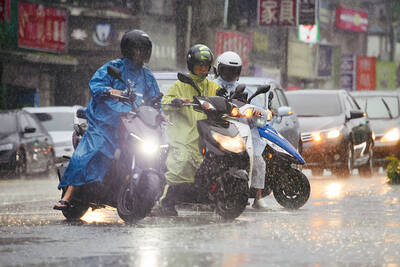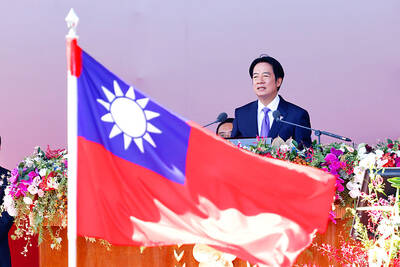Deputy Minister of National Defense Andrew Yang (楊念祖) told a Washington symposium on Tuesday that although President Ma Ying-jeou’s (馬英九) administration was doing everything in its power to maintain peace, it still considered China a “major threat.”
“We are fully aware that we are facing a clear and present threat from the other side of the Taiwan Strait,” he said.
Yang, on a short private visit to the US, said he had not spoken with US officials about the possible sale of F-16C/D fighter planes and that he had received no updated information.
A response to Taiwan’s request to buy 66 of the planes is expected before the end of this year.
There was little more that Taiwan could do to persuade the US to sell the fighters, he said, adding: “It is up to the US to make a decision, or not.”
Yang was speaking at a symposium organized by the Washington-based “Project 2049 Institute” to release a new report titled Evolving Aerospace Trends in the Asia-Pacific Region — Implications for Stability in the Taiwan Strait.
He said that Chinese missiles arrayed against Taiwan sent a “very negative message” because they represented an intention to use non-peaceful means to reach Beijing’s goals.
A Chinese assault, he said, could begin with a “massive missile attack” attempting to neutralize Taiwan’s defense infrastructure and major political centers.
The country, he said, had to “try its best” to survive such an attack and demonstrate that it could “stand up against the aggressors.”
He said that he hoped Beijing would realize that the use of force would not succeed and that even if it did, it would result in a regional disaster.
Asked about the crisis caused by the sinking of a South Korean warship by a North Korean submarine, Yang said the incident showed friction could have a great impact on regional security and stability. He said he hoped Beijing would also learn from what had happened and avoid miscalculation.
The report said that the potential for a Chinese military attack on Taiwan remained the “primary flash point” in the Asia-Pacific region.
“It is also the contingency that most likely would bring the US and China, as well as others in the region, into armed conflict,” the report said.
Written by Mark Stokes, a US expert on Taiwan’s military affairs and executive director of the “Project 2049 Institute,” the report said a “relative erosion” of Taiwan’s military capabilities could create opportunities and incentives for Beijing’s political and military leadership to take greater risks in cross-strait relations, “including resorting to force to resolve political differences.”
In order to deter perceived moves toward de jure independence, China sought the capacity to dominate the skies over Taiwan, the report said.
The Taiwan independence “threat” also conveniently justified the People’s Liberation Army’s (PLA) budget increases at a time when money was tight, the report added.
“It also allows for an accelerated pace of modernization without excessive alarm from others in the region. The focus on Taiwan is useful in developing capabilities applicable to other contingencies around China’s periphery,” the report said.
It recommended the US adopt a mixture of positive and negative incentives to persuade civilian leaders in Beijing to increase their commitment to peaceful means to resolve political differences with Taipei and to reduce the missile deployment opposite Taiwan.
Because anti-missile systems and other defenses were insufficient to undercut “the coercive and military utility” of China’s ballistic missiles and land attack cruise missiles (LACM), the report said that Taiwan’s reported program to field the Hsiungfeng-2E indigenous LACM was “not without reason.”
In 2005, media reports alleged that at least 24 launchers had been manufactured, along with an unknown number of missiles that could cover more than 20 targets in southeast China. More recently, media reports highlighted further testing of the HF-2E, with plans to produce at least 80 HF-2E LACMs with a range of more than 500km by the end of this year.
“A second track could be to begin assessing options for a multi-role fighter able to operate from shorter runways. A variety of options are worth considering, including the eventual release of the F-35B, the transfer of an existing Vertical and/or Short Take-Off and Landing (VSTOL) design, such as the AV-8B, or the initiation of design work on a VSTOL-capable advanced indigenous defense fighter,” the report said.
Many US experts believe Taiwan should buy or develop a VSTOL fighter because China will try to destroy runways early in a conflict.
A third track, the report said, would be the “principled release” of additional F-16s to Taiwan as an interim bridge to the fielding of a VSTOL airframe.
“Release of additional F-16s would be an appropriate and measured response to the PRC’s growing reliance on ballistic missiles as an instrument of coercion,” the report said. “Should Beijing demonstrate clear intent to redeploy or draw down its five confirmed short range ballistic missile (SRBM) brigades opposite Taiwan, then formal notification to Congress could be deferred. Such an approach constitutes a form of reciprocal unilateralism. However, explicit negotiations linking PRC ballistic missile deployments with US arms sales to Taiwan would be neither appropriate nor desirable.”

The combined effect of the monsoon, the outer rim of Typhoon Fengshen and a low-pressure system is expected to bring significant rainfall this week to various parts of the nation, the Central Weather Administration (CWA) said. The heaviest rain is expected to occur today and tomorrow, with torrential rain expected in Keelung’s north coast, Yilan and the mountainous regions of Taipei and New Taipei City, the CWA said. Rivers could rise rapidly, and residents should stay away from riverbanks and avoid going to the mountains or engaging in water activities, it said. Scattered showers are expected today in central and

People can preregister to receive their NT$10,000 (US$325) cash distributed from the central government on Nov. 5 after President William Lai (賴清德) yesterday signed the Special Budget for Strengthening Economic, Social and National Security Resilience, the Executive Yuan told a news conference last night. The special budget, passed by the Legislative Yuan on Friday last week with a cash handout budget of NT$236 billion, was officially submitted to the Executive Yuan and the Presidential Office yesterday afternoon. People can register through the official Web site at https://10000.gov.tw to have the funds deposited into their bank accounts, withdraw the funds at automated teller

COOPERATION: Taiwan is aligning closely with US strategic objectives on various matters, including China’s rare earths restrictions, the Ministry of Foreign Affairs said Taiwan could deal with China’s tightened export controls on rare earth metals by turning to “urban mining,” a researcher said yesterday. Rare earth metals, which are used in semiconductors and other electronic components, could be recovered from industrial or electronic waste to reduce reliance on imports, National Cheng Kung University Department of Resources Engineering professor Lee Cheng-han (李政翰) said. Despite their name, rare earth elements are not actually rare — their abundance in the Earth’s crust is relatively high, but they are dispersed, making extraction and refining energy-intensive and environmentally damaging, he said, adding that many countries have opted to

PEACE AND STABILITY: Maintaining the cross-strait ‘status quo’ has long been the government’s position, the Ministry of Foreign Affairs said Taiwan is committed to maintaining the cross-strait “status quo” and seeks no escalation of tensions, the Ministry of Foreign Affairs (MOFA) said yesterday, rebutting a Time magazine opinion piece that described President William Lai (賴清德) as a “reckless leader.” The article, titled “The US Must Beware of Taiwan’s Reckless Leader,” was written by Lyle Goldstein, director of the Asia Program at the Washington-based Defense Priorities think tank. Goldstein wrote that Taiwan is “the world’s most dangerous flashpoint” amid ongoing conflicts in the Middle East and Russia’s invasion of Ukraine. He said that the situation in the Taiwan Strait has become less stable